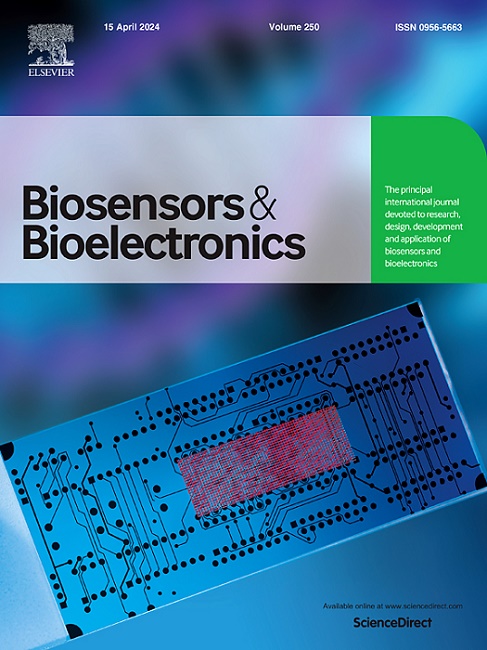利用空间隔离的金铈进行级联酶模拟,实现超氧阴离子的双模式检测
IF 10.7
1区 生物学
Q1 BIOPHYSICS
引用次数: 0
摘要
具有空间分离异质结构的哑铃状 Au-CeO2 金属半导体纳米酶具有类似超氧化物歧化酶(SOD)和过氧化物酶(POD)的级联活性,可用于检测超氧阴离子。它是通过在金纳米棒(Au NR)两端选择性生长 CeO2 而合成的。利用金纳米棒优异的局部表面等离子体共振(LSPR)效应,与连续生长的核壳结构 Au@CeO2 相比,空间分离的 Au-CeO2 具有更高的光热效应。同时,在808 nm激光照射下,Au NR的热电子可以转移到CeO2上,改变CeO2上Ce3+/Ce4+氧化还原偶的比例,促进H2O2的分解,从而提高类POD活性。基于 Au-CeO2 的 SOD 类活性,超氧阴离子(O2--)可转化为过氧化氢(H2O2)。通过级联催化和光热效应,实现了O2--的吸光度和温度传感双模式检测,检测范围从nM到μM,即0.1-150 μM,LOD为0.033 μM(信噪比为3)。该方法适用于癌症和正常细胞样本,准确度和回收率令人满意。本文章由计算机程序翻译,如有差异,请以英文原文为准。
Cascade enzyme-mimicking with spatially separated gold-ceria for dual-mode detection of superoxide anions
Metal-semiconductor nanozyme of dumbbell Au-CeO2 with spatially separated heterostructure has cascade superoxide dismutase (SOD)-like and peroxidase (POD)-like activities for superoxide anions detection. It was synthesized by selective growth of CeO2 at the ends of Au nanorod (Au NR). Taking advantage of the excellent local surface plasmon resonance (LSPR) effect of Au NR, the spatially separated Au-CeO2 has a higher photothermal effect than the continuously growing core-shell structure of Au@CeO2. Meanwhile, the hot electrons of Au NR could transfer to CeO2 under 808 nm laser irradiation, changing the ratio of Ce3+/Ce4+ redox couples over CeO2 and facilitating H2O2 decomposition thus enhancing POD-like activity. Based on the SOD-like activity of Au-CeO2, superoxide anion (O2·−) can be transformed into hydrogen peroxide (H2O2). Dual-mode including absorbance and temperature sensing detection of O2·−, with the detection range from nM to μM i.e., 0.1–150 μM and LOD of 0.033 μM (S/N = 3) was achieved through the cascade catalysis and photothermal effect. The as-proposed method was applicable to both cancer and normal cell samples with satisfactory accuracy and recovery.
求助全文
通过发布文献求助,成功后即可免费获取论文全文。
去求助
来源期刊

Biosensors and Bioelectronics
工程技术-电化学
CiteScore
20.80
自引率
7.10%
发文量
1006
审稿时长
29 days
期刊介绍:
Biosensors & Bioelectronics, along with its open access companion journal Biosensors & Bioelectronics: X, is the leading international publication in the field of biosensors and bioelectronics. It covers research, design, development, and application of biosensors, which are analytical devices incorporating biological materials with physicochemical transducers. These devices, including sensors, DNA chips, electronic noses, and lab-on-a-chip, produce digital signals proportional to specific analytes. Examples include immunosensors and enzyme-based biosensors, applied in various fields such as medicine, environmental monitoring, and food industry. The journal also focuses on molecular and supramolecular structures for enhancing device performance.
 求助内容:
求助内容: 应助结果提醒方式:
应助结果提醒方式:


